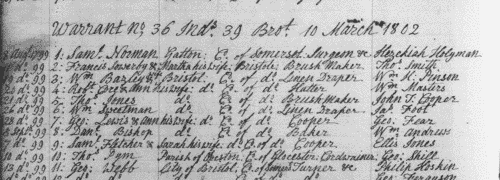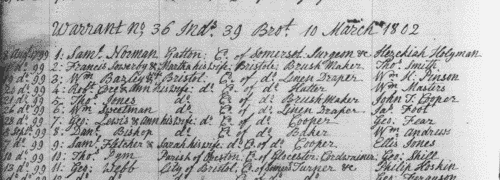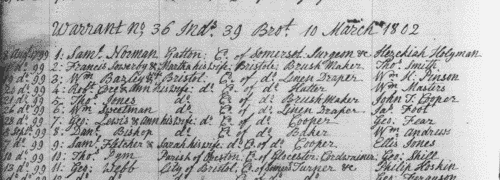 Masters of apprentices registered in Herefordshire
(1803) Masters of apprentices registered in Herefordshire
(1803)
Apprenticeship indentures and clerks' articles were subject to a 6d or 12d per pound stamp duty: the registers of the payments usually give the master's trade, address, and occupation, and the apprentice's name, as well as details of the date and length of the apprenticeship. There are central registers for collections of the stamp duty in London, as well as returns from collectors in the provinces. These collectors generally received duty just from their own county, but sometimes from further afield. The indentures themselves can date from a year or two earlier than this return. (The sample entry shown on this scan is taken from a Bristol return. Each entry has two scans, the other being the facing page with the details of the indenture, length of service, and payment of duty.) IR 1/70TAYLOR. Cost: £8.00.  | Sample scan, click to enlarge

|
 Masters of apprentices registered in Northampton
(1803) Masters of apprentices registered in Northampton
(1803)
Apprenticeship indentures and clerks' articles were subject to a 6d or 12d per pound stamp duty: the registers of the payments usually give the master's trade, address, and occupation, and the apprentice's name, as well as details of the date and length of the apprenticeship. There are central registers for collections of the stamp duty in London, as well as returns from collectors in the provinces. These collectors generally received duty just from their own county, but sometimes from further afield. The indentures themselves can date from a year or two earlier than this return. (The sample entry shown on this scan is taken from a Bristol return. Each entry has two scans, the other being the facing page with the details of the indenture, length of service, and payment of duty.) IR 1/70TAYLOR. Cost: £8.00.  | Sample scan, click to enlarge

|
 Masters of apprentices registered in Nottinghamshire
(1803) Masters of apprentices registered in Nottinghamshire
(1803)
Apprenticeship indentures and clerks' articles were subject to a 6d or 12d per pound stamp duty: the registers of the payments usually give the master's trade, address, and occupation, and the apprentice's name, as well as details of the date and length of the apprenticeship. There are central registers for collections of the stamp duty in London, as well as returns from collectors in the provinces. These collectors generally received duty just from their own county, but sometimes from further afield. The indentures themselves can date from a year or two earlier than this return. (The sample entry shown on this scan is taken from a Bristol return. Each entry has two scans, the other being the facing page with the details of the indenture, length of service, and payment of duty.) IR 1/70TAYLOR. Cost: £8.00.  | Sample scan, click to enlarge

|
 Masters of apprentices registered in Oxfordshire
(1803) Masters of apprentices registered in Oxfordshire
(1803)
Apprenticeship indentures and clerks' articles were subject to a 6d or 12d per pound stamp duty: the registers of the payments usually give the master's trade, address, and occupation, and the apprentice's name, as well as details of the date and length of the apprenticeship. There are central registers for collections of the stamp duty in London, as well as returns from collectors in the provinces. These collectors generally received duty just from their own county, but sometimes from further afield. The indentures themselves can date from a year or two earlier than this return. (The sample entry shown on this scan is taken from a Bristol return. Each entry has two scans, the other being the facing page with the details of the indenture, length of service, and payment of duty.) IR 1/70TAYLOR. Cost: £8.00.  | Sample scan, click to enlarge

|
 Masters of apprentices registered in Suffolk
(1803) Masters of apprentices registered in Suffolk
(1803)
Apprenticeship indentures and clerks' articles were subject to a 6d or 12d per pound stamp duty: the registers of the payments usually give the master's trade, address, and occupation, and the apprentice's name, as well as details of the date and length of the apprenticeship. There are central registers for collections of the stamp duty in London, as well as returns from collectors in the provinces. These collectors generally received duty just from their own county, but sometimes from further afield. The indentures themselves can date from a year or two earlier than this return. (The sample entry shown on this scan is taken from a Bristol return. Each entry has two scans, the other being the facing page with the details of the indenture, length of service, and payment of duty.) IR 1/70TAYLOR. Cost: £8.00.  | Sample scan, click to enlarge

|
 Masters of apprentices registered in Wiltshire
(1803) Masters of apprentices registered in Wiltshire
(1803)
Apprenticeship indentures and clerks' articles were subject to a 6d or 12d per pound stamp duty: the registers of the payments usually give the master's trade, address, and occupation, and the apprentice's name, as well as details of the date and length of the apprenticeship. There are central registers for collections of the stamp duty in London, as well as returns from collectors in the provinces. These collectors generally received duty just from their own county, but sometimes from further afield. The indentures themselves can date from a year or two earlier than this return. (The sample entry shown on this scan is taken from a Bristol return. Each entry has two scans, the other being the facing page with the details of the indenture, length of service, and payment of duty.) IR 1/70TAYLOR. Cost: £8.00.  | Sample scan, click to enlarge

|
 Masters of apprentices registered in Yorkshire
(1803) Masters of apprentices registered in Yorkshire
(1803)
Apprenticeship indentures and clerks' articles were subject to a 6d or 12d per pound stamp duty: the registers of the payments usually give the master's trade, address, and occupation, and the apprentice's name, as well as details of the date and length of the apprenticeship. There are central registers for collections of the stamp duty in London, as well as returns from collectors in the provinces. These collectors generally received duty just from their own county, but sometimes from further afield. The indentures themselves can date from a year or two earlier than this return. (The sample entry shown on this scan is taken from a Bristol return. Each entry has two scans, the other being the facing page with the details of the indenture, length of service, and payment of duty.) IR 1/70TAYLOR. Cost: £8.00.  | Sample scan, click to enlarge

|
Subscribers to Immateriality &c.
(1803)
'An Original Essay on the Immateriality and Immortality of the Human Soul, founded solely on Physical and Rational Principles', by S. Drew, published in Bristol in 1803, attracted a numerous subscription, almost exclusively from Cornwall.TAYLOR. Cost: £6.00.  | Sample scan, click to enlarge

|
Subscribers to 'Poetical Scraps'
(1803)
'Poetical Scraps' by Thomas Clio Rickman of Upper Marylebone Street (author of 'The Evening Walk', 'Letter to Mr Pitt', 'To the Bishop of Landaff', &c. was published by the author, in London, in 1803, and sold also by Mr Symonds, Paternoster Row; Mr Fisher, at his Library, on the Steyne, Brighton; Mr Lee, Lewes; Mr Claris, Canterbury; Mr Flower, Cambridge; Mr Watts, Gosport; Messrs Gore and Son, Liverpool; Mr Cowdroy, Manchester; and Mr Rackham, Bury St Edmunds.TAYLOR. Cost: £4.00.  | Sample scan, click to enlarge

|
 Apprentices and clerks
(1804) Apprentices and clerks
(1804)
Apprenticeship indentures and clerks' articles were subject to a 6d or 12d per pound stamp duty: the registers of the payments usually give the master's trade, address, and occupation, and the apprentice's name, as well as details of the date and length of the apprenticeship. 2 January to 31 December 1804. IR 1/39TAYLOR. Cost: £8.00.  | Sample scan, click to enlarge

|
Research your ancestry, family history, genealogy and one-name study by direct access to original records and archives indexed by surname.












